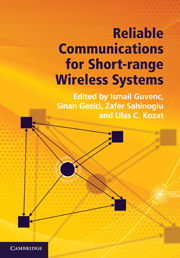1 - Short-range wireless communications and reliability
Published online by Cambridge University Press: 01 June 2011
Summary
Even though there is no universally accepted definition, short-range wireless communications typically refers to a wide variety of technologies with communication ranges from a few centimeters to several hundreds of meters. While the last three decades of the wireless industry have been mostly dominated by cellular systems, short-range wireless devices have gradually become a more integrated part of our everyday lives over the last decade. The Wireless World Research Forum (WWRF) envisions that this trend will accelerate in the upcoming years: by the year 2017, it is expected that seven billion people in the world will be using seven trillion wireless devices [1]. The majority of these devices will be short-range wireless devices that interconnect people with each other and their environments.
While the reliability of wireless communication systems has been studied in detail in the past, a comprehensive study of different factors affecting reliability for short-range wireless systems and how they can be handled is not available in the literature, to date. The present book intends to fill this gap by covering important reliability problems for short-range wireless communication systems. The scope of the contributions in the book is mostly within the domain of wireless personal area networks (WPANs) and wireless sensor networks (WSNs), and issues related to wireless local area networks (WLANs) are not specifically treated.
Due to the differences in application scenarios, quality of service (QoS) requirements, signaling models, and different error sources and mitigation approaches, the high-rate and low-rate systems will be addressed in separate parts of the book.
- Type
- Chapter
- Information
- Publisher: Cambridge University PressPrint publication year: 2011



